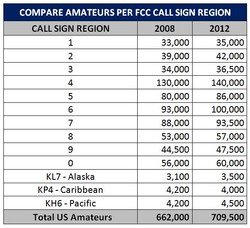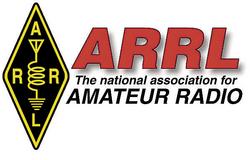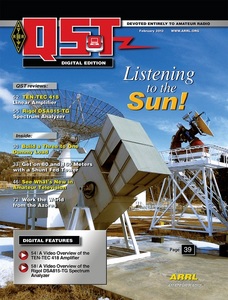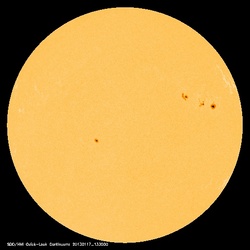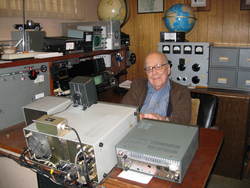 January 17, 2013 John E. Ross, KD8IDJ, Editor
| |||||||
+ Available on ARRL Audio News. + 2012 Marks All-Time High for Amateur Radio Licenses As 2012 came to a close, ARRL VEC Manager Maria Somma, AB1FM, had a good reason to cheer: The number of radio amateurs in the US reached an all-time high of almost 710,000. "2012 was definitely a banner year for the number of Amateur Radio operators here in the US," she said. "It is amazing to see these new numbers and to know that Amateur Radio is experiencing such a healthy trend."
In looking at new and upgraded licenses, as well as licensees per ARRL Division, Somma also crunched the numbers looking for growth within each license class -- and all of Amateur Radio -- over the last 40 years. "This is an all-time high for Technician, General and Amateur Extra class licensees," she said. "When looking at the three current license classes, the number of Technicians, Generals and Amateur Extras peaked in December at 345,369, 163,370 and 130,736, respectively." Somma explained that the total number of US amateurs in the FCC database also continues to grow each year: "As of December 31, 2012, the number of licensees reached an all-time high of 709,575; year-end totals were 702,056 for 2011 and 696,041 for 2010. The number of licensees increased at an average rate of 21 per day, while the number of US licensees has increased by 7 percent since 2008!" More than 3000 new licenses were issued in 2012 than in 2011, while upgraded license activity remained steady in 2012. Read more here. + On the Air: 2012 Brought Increase in DXCC Applications, ARRL QSL Bureau Card Processing With the coming of more sunspots comes more DX. And when more amateurs work DX, the ARRL's Membership and Volunteer Programs Department -- especially the DXCC Desk and the ARRL Incoming and Outgoing QSL Bureaus -- goes into high gear. "In 2012, we saw an increase in the number of cards received from ARRL members that were sent to foreign QSL bureaus, as well as the number of cards we sent out to the bureaus," said Membership and Volunteer Programs Administrative Manager Sharon Taratula. "In addition, the number of DXCC applications -- including those for initial awards and endorsements -- also increased." Read more here. + ARRL Board of Directors: 2013 Annual Meeting Set for January 18-19 in New Orleans, Agenda Announced
ARRL policy is made by its Board of Directors. The 15 voting members of the Board are the Directors who are elected by the ARRL members in their respective divisions. The Board meets in January and July, usually in the Hartford area; however, this year, the meeting will take place in New Orleans, Louisiana. ARRL members also elect Vice Directors who may attend the meetings. ARRL Directors and Vice Directors are volunteers who work hard to represent the ARRL in their Divisions, to represent the members who elect them on policy issues and to conduct the committee work that is so important to good decision-making. This month's Board Meeting activities will begin on Thursday, January 17 with meetings of two standing committees, the Administration & Finance (A&F) Committee and the Programs & Services Committee. Each is made up of five Directors and a Vice Director, with the treasurer serving as an additional member of the A&F Committee. The Board Meeting itself begins on Friday morning, January 18 and is expected to run through Saturday afternoon. Read more here. + Check Out the February Issue of QST The February issue of QST takes a look at how Canada's Dominion Radio Astrophysical Observatory (DRAO) measures and processes the 10.7 centimeter solar flux and why this number is important to hams. As radio amateurs, we are interested in the Sun and how it affects the ionosphere. By gauging the Sun's activity -- primarily in the form of sunspots and solar flux -- hams can predict how the bands will perform and what the maximum useable frequency (MUF) might be, paving the way to good DX on the higher bands. So grab your print edition of QST -- or cozy up to your computer or tablet to read the digital version -- and discover all the fun that is Amateur Radio.
In their article "The Penticton Solar Flux Receiver," John White, VA7JW, and DRAO's Dr Ken Tapping delve into the mystery and science of the 10.7 centimeter solar flux, the measurement of the total amount of solar radio emission in a 100 megahertz-wide band that is centered on a frequency of 2800 MHz, or 10.7 centimeters. While the print article is full of information, more is available in the digital edition of the February issue of QST. While many amateurs know how long to make their wire antennas for each band, they might not know just how high up to place them. QST Technical Editor Joel R. Hallas, W1ZR, tackles this very question in his article "How High Should You Hang that Wire Antenna?" The aftermath of October's Hurricane Sandy wreaked havoc in New York and New Jersey. This "superstorm" brought together Amateur Radio operators from all over the region who not only volunteered their time and equipment to provide communications support, but also to the humanitarian relief effort. In his article "Disaster on Long Island," Bob Myers, K2TV, tells the story of how one local club reached out to their communities and put their talents to use. The ARRL will celebrate 100 years in 2014 and ARRL Volunteer Historian Mike Marinaro, WN1M, has been busy preserving and conserving the many Amateur Radio artifacts that the League has in its possession. In his article "A Professional Approach to Amateur History," he tells of what he, other volunteers and ARRL staff have been doing to document and display the League's extensive collection. QST Technical Editor Joel R. Hallas, W1ZR, takes a look at the TEN-TEC Model 418 100 W HF and 6 meter linear amplifier in this month's Product Review. He says this amplifier "can provide a handy 13 dB boost to low power radios if used where enough dc power is available. While the model 418 is designed as a companion to the soon-to-be-released Argonaut IV 5 W transceiver, it can also operate seamlessly with other transceivers of the same power class." ARRL Test Engineer Bob Allison, WB1GCM, checked out the Rigol Technologies DSA815-TG spectrum analyzer, saying that it "is a lightweight, portable spectrum analyzer that is affordable for serious experimenters and self-employed service technicians. It has many uses in the amateur workshop." You can find video overviews of both the TEN-TEC amplifier and the Rigol Technologies spectrum analyzer in the digital edition of the February issue of QST. Of course, there are the usual columns you know and have come to expect in the February QST: Happenings, Hints & Kinks, The Doctor is In, Short Takes, Vintage Radio, How's DX? and more, including lots of new books and products. Look for your February issue in your mailbox and in your inbox. QST is the official journal of the ARRL, the national association for Amateur Radio. QST is just one of the many benefits of ARRL membership. To join, or to renew your ARRL membership, please see the ARRL web page. + Dayton Hamvention®: Hamvention Awards Nomination Deadline Extended to February 15
There is still time to nominate a radio amateur for the 2013 Dayton Hamvention® Awards: Amateur of the Year, Club of the Year, the Special Achievement Award and the Technical Excellence Award. The deadline for nominations has been extended to Friday, February 15. Anyone may nominate a person or club for these awards, and all Amateur Radio operators are eligible to receive these awards. The winners will be recognized at the 2013 Dayton Hamvention, which runs May 17-19. Read more here. Solar Update
Tad Cook, K7RA, reports: Solar activity pulled back over the past week, following a stellar performance in the week prior. The average daily sunspot numbers were down 34.3 points to 129, but the average daily solar flux actually rose 9.7 points to 157.4. The current prediction for solar flux is 135 on January 17-18, 130 and 125 on January 19-20, 120 on January 21-23, 130 on January 24-25, 135 on January 26-28, 130 and 135 on January 29-30, 140 on January 31-February 1, 150 on February 2, 155 on February 3-4, and back down to 150 on February 5-11. The predicted planetary A index is 12 on January 17, 8 on January 18-19, 5 on January 20-21, 8 on January 22-23, 5 on January 24-February 4, 8 on February 5, 5 on February 6-8, 8 on February 9-10 and back down to 5 on February 11 through the beginning of March. The most active geomagnetic day this past week was January 13, but only in relation to very, very quiet recent conditions. The mid-latitude A index was 10, while the K index only reached 4 in one 3-hour period. The college A index (from Fairbanks, Alaska) was 11 and 12 on January 13-14, with the K index reaching 4 in two 3-hour periods on February 13, and 5 in one 3-hour period on February 14. Look for more on the ARRL website on Friday, January 18. For more information concerning radio propagation, visit the ARRL Technical Information Service Propagation page. + Silent Key: #1 Mixed DXCC John Dack, W7KH (SK)
On Monday, January 7, John Dack, W7KH, of Seattle, Washington, passed away. He was 91. An ARRL Life Member, Dack sat at the top of the DXCC mixed standings with 398 entities, including all 340 current entities and 58 deleted entities. He worked every DXCC entity except Damau Diu (CR8), French Indochina (FI8) and Manchuria (C9). South Sudan (ST0) was the last new DX entity in Dack's log; he worked ST0R in August 2011. Dack was profiled in the September 2011 issue of QST in the "How's DX?" column [Editor's note: You must be an ARRL member and logged on to the ARRL website to read this article]. First licensed in 1938 when he was 17, Dack became interested in Amateur Radio due to some neighbors who were hams. "John remembered working Mexico, and this may have been the beginning of his interest in working DX, as he felt 'like he had just worked Tibet,' which he later did," wrote "How's DX?" conductor Bernie McClenny, W3UR. "Despite being [at the time] 90 years old, he still seems to be on top of his game and gets on the air about twice a week. There are no computers at W7KH and John still gets his DX news from the paper version of QRZ DX. All of his logs are still done with paper and pencil." This Week in Radiosport This week:
Next week:
All dates, unless otherwise stated, are UTC. See the ARRL Contest Branch page, the ARRL Contest Update and the WA7BNM Contest Calendar for more information. Looking for a Special Event station? Be sure to check out the ARRL Special Event Stations web page. Upcoming ARRL Section, State and Division Conventions and Events
To find a convention or hamfest near you, click here. ARRL -- Your One-Stop Resource for Amateur Radio News and Information Join or Renew Today! ARRL membership includes QST, Amateur Radio's most popular and informative journal, delivered to your mailbox each month. Subscribe to NCJ - the National Contest Journal. Published bi-monthly, features articles by top contesters, letters, hints, statistics, scores, NA Sprint and QSO Parties. Subscribe to QEX -- A Forum for Communications Experimenters. Published bi-monthly, features technical articles, construction projects, columns and other items of interest to radio amateurs and communications professionals. Free of charge to ARRL members: Subscribe to the ARES E-Letter (monthly public service and emergency communications news), the ARRL Contest Update (bi-weekly contest newsletter), Division and Section news alerts -- and much more! Find us on Facebook. Follow us on Twitter. ARRL offers a wide array of products to enhance your enjoyment of Amateur Radio. Donate to the fund of your choice -- support programs not funded by member dues! Click here to advertise in this newsletter (subject to space availability). | |||||||
